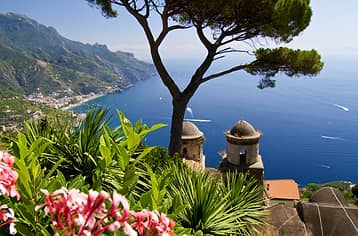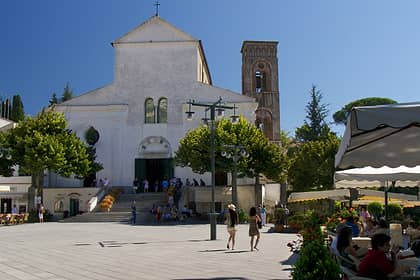Ravello - Italy





Known as the "balcony of the Amalfi Coast"
Unlike the majority of towns on Italy's Amalfi Coast, Ravello isn't located on the seaside. To get to this beautiful clifftop town you'll need to exit the SS163 between Amalfi and Minori and head inland north for about 3 kilometers.
How to get to Ravello
How to get to Ravello
You can reach Ravello by making your way down the Chiunzi Pass, which you can access from the A3 motorway from Naples, exiting at Angri. It takes about 90 minutes to reach Ravello from Naples and Salerno; times can vary significantly depending on traffic. In addition, the Sita coach company operates a bus service to Ravello from Amalfi.
Driving times from other locations in Campania - Italy:
From Amalfi to Ravello: 17 minutes
From Atrani to Ravello: 15 minutes
From Positano to Ravello: 55 minutes
From Praiano to Ravello: 50 minutes
From Sorrento to Ravello: 1 hour 20 minutes (Given the distance from Sorrento to Ravello, we suggest breaking up the drive with a stop in Positano)
From Salerno to Ravello: 1 hour
From Capri to Ravello: 20-minute ferry to Sorrento, then 80 minutes
From Pompeii to Ravello: 45 minutes
From Naples to Ravello: 1 hour
From Naples Capodichino Airport (the closest airport to Ravello): about 1 hour
From Rome to Ravello: 3 hours 15 minutes
For more detailed directions and information on how to get from the Naples airport to Ravello: How to get to the Amalfi Coast
What to see in Ravello
What to see in Ravello
The Italian village of Ravello is one of the quietest along the Amalfi Coast, set a bit away from the seaside and the busy beaches. Though equally lovely, Ravello is never as crowded as Positano or Amalfi, especially in the evening when most of the day-trippers have left and the streets are refreshingly empty.
Known as the "City of Music," Ravello has always been a favorite retreat for artists and intellectuals looking for inspiration from the sweeping vistas far from the bustle of the coastline.
Over the past two centuries, musicians and composers like Wagner, Grieg, Rostropovich, Toscanini, and Bernstein have taken refuge here, as have artists like Escher, Turner, and Mirò and writers from Lawrence and Forster to Virginia Woolf.
It comes as no surprise, then, that this sleepy village hosts important cultural events such as the Ravello Festival and chamber music concerts organized by the Ravello Concert Society.
The most spectacular views in Ravello
Belvedere della Principessa di Piemonte
The Terrace of Infinity at Villa Cimbrone
The terraces at Villa Rufolo
History
History
Wonderfully aristocratic and breathtakingly beautiful, Ravello sits above the Amalfi Coast's seaside fishing villages, perched on a great spur of rock some 350 meters above the Mediterranean Sea.
Ravello was built on the site of a settlement believed to have been built by a Roman colony fleeing the Barbarian invasions. In the 9th century, it became the chosen refuge of a group of noble families from Amalfi who had rebelled against the authority of the Doge.
Ravello soon prospered thanks to the production of the town's "Celendra" wool, and in the 11th century it attempted to dissolve its ties with the Maritime Republic of Amalfi by nominating its own Duke.
The town's decline coincided with the Norman Conquest. Over the ensuing centuries the population of Ravello, which in the 12th century had been circa 25,000, diminished to such an extent that in 1800 the town was aggregated with the Diocese of Amalfi.
However drastic, Ravello's change in fortune failed to impair its charm. If anything, it preserved it, making Ravello the chosen destination of inspiration-seeking intellectuals, artists, and celebrities from every corner of the globe.
Seduced by Ravello:
Greta Garbo
D.H. Lawrence
Gore Vidal
Richard Wagner
Winston Churchill
Virginia Woolf
Ravello Cathedral
Ravello Cathedral

The Duomo, erected in 1086, dominates Piazza Vescovado with its splendid, triple-arched marble portal and magnificent bronze door created in 1179 by Parisano da Trani.
The cathedral's museum is more than worthy of a visit if only to admire the splendid marble bust of Sigligaida Rufolo, widely considered to be one of the most beautiful works of 13th-century art.
Oscar Niemeyer Auditorium
Oscar Niemeyer Auditorium

A cultural bridge between the past and future, Ravello provides the setting for the controversial Auditorium by Oscar Niemeyer, an international design legend.
A powerful work of modern architecture bang in the heart of a UNESCO World Heritage Site, the 400-seat auditorium has been likened to a sheet of white paper blowing in the wind.
Villa Rufolo
Villa Rufolo

The tower that faces Piazza del Vescovado originally served as a watchtower for Villa Rufolo, one of the most important architectural masterpieces in southern Italy, which has contributed to Ravello's worldwide fame.
The villa was built in the latter half of the 13th century by the powerful Rufolo family.
Both Moorish and Norman influences can be seen in the towers and cloisters, the latter characterized by a double order of loggias and pointed arches.
The grounds of the villa are as famous as the building itself.
The magnificent cliff-edge terrace offers unforgettable sea views and is the venue for the Ravello music festival known as the Wagner Festival.
Wagner stayed in Villa Rufolo in 1880 while composing his Parsifal, and was so enamored by the place that he declared "the magic garden of Klingsor has been found".
Villa Rufolo: practical info
Hours: 9 am-5 pm daily, open in the evenings for special events
Price: 10 euros
Reservations aren't required. For safety reasons, children under age 5 are not allowed into the tower.
Villa Cimbrone
Villa Cimbrone

Villa Cimbrone is the visionary work of Lord William Beckett, who in 1904 purchased what was then a long-abandoned farmhouse and transformed it into a splendid residence. He used an eclectic mix of architectural styles and eras, as well as archeological artifacts and souvenirs from his extensive travels.
These luxuriant Ravello gardens are home to many rare botanical species, but also statues, fountains, temples and artificial grottos, all of which reflect the passion for antiquity so in vogue at the time of its construction.
The paths which traverse the garden culminate in the Infinity Terrace and one of the most beautiful views in the world.
Villa Cimbrone: practical info
Villa Cimbrone is currently a hotel, but the gardens are open to the public.
Hours: from 9 am to sunset daily
Price: 10 euros per person
Contact the hotel to book a guided tour.
Villa Cimbrone official website
More things to do in Ravello:
Coral museum
Church of San Giovanni del Toro
Church of Santa Maria a Gradillo
Church of San Francesco
Palazzo della Marra
Scala
Ravello wine tour
Cooking class
Limoncello tasting tour
Where to eat in Ravello
Where to eat in Ravello
Gourmet dinner: Ristorante Rossellinis in Palazzo Avino, an elegant and romantic restaurant with Michelin-starred dishes served overlooking the Amalfi Coast.
Lunch in the town center: Ristorante Vittoria, an understated restaurant with stone vaults and vintage photos decorating the walls. There is also a small garden for outdoor dining.
For pizza: Da Mimì, a traditional pizzeria set directly above the water with a large outdoor dining space where you can enjoy an authentic pizza Napoletana topped with area specialties such as anchovies from Cetara or zucchini alla Nerano inspired by the famous spaghetti dish.
Where to stay in Ravello
Where to stay in Ravello
Ravello has been a favorite stop for travelers since the Grand Tour and is home to a number of prestigious luxury hotels.
If you're looking for a charming inn, in Castiglione di Ravello you can book at Villa San Michele, a 3-star hotel with a private beach and gourmet restaurant.
Villa Principessa is a luxury property with refined interiors, an infinity pool, and private beach access.
If you'd like to sleep at the landmark Villa Cimbrone, the English aristocracy's preferred bolthole for centuries, contact Hotel Villa Cimbrone, one of the most panoramic 5-star hotels on the entire Amalfi Coast.
FAQ - Frequently asked questions
Villa Rufolo: hours, tickets and prices
Open every day from 9 AM to 7 PM
Tickets: EUR 8 for adults, EUR 6 for kids 5-12 and visitors over 65. Children under 5 free of charge.
Villa Cimbrone: hours, tickets and prices
Open: every day from 9 AM to 7 PM
Tickets: EUR 10
How long does it take to visit Ravello?
Ravello is a small city, but has many places to visit. If you wish to visit Villa Cimbrone, Villa Rufolo and the Duomo, you should allow at least 4-5 hours. You can combine it with a visit to Amalfi to make for a full day, since they're only 10 minutes apart by bus.